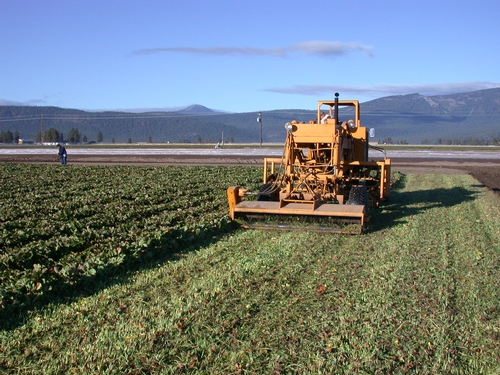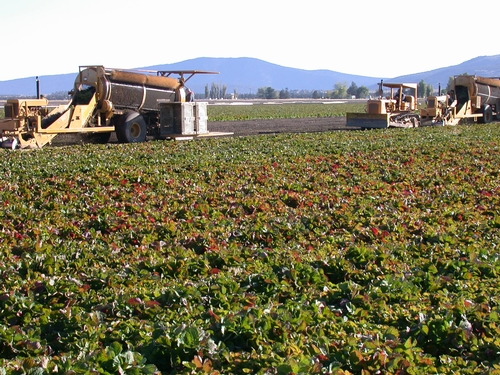
Posts Tagged: transplant
Mechanical Transplant of Strawberry
Nice clip here of a mechanical transplant operation underway in Santa Maria just a few days ago.
https://www.youtube.com/watch?v=PwBpDsF-lNE&feature=youtu.be
Great photography shot out of a drone.
The people running this machine clearly understand the dynamics of this system better than I do, but from a horticultural perspective I am looking closely at two things:
1. The machine is planting plugs (alleviating my concern about "J" rooting!).
2. How will the plug plants respond to a summer planting scenario, given (as far as I understand) that they have no cold conditioning.
Nice to see this sort of progress in the industry.
H/T colleague Surendra Dara who turned me on to this video.
Mark
X
Heads Up About the Potential for Salt Damage in Berries
People should be super aware right now that the lack of rain we are experiencing is certain to exacerbate salt problems in berries this winter. I’ve been driving around a bit visiting fields, growers and PCA’s and the problem doesn’t yet seem too bad although I am starting to see a little bit of damage here and there. Still, I have a strong sense of foreboding that this could get big as the season progresses on the Central Coast without any rain.
See the pictures below from colleague Steven Koike for what salt damage looks like in strawberries.
Key points to keep in mind regarding winter management of salinity (Many thanks to Dr. Stuart Styles from Cal Poly in San Luis Obispo for giving me a copy of the entire data notebook of his work on salinity in strawberries from which I draw the points below - I treasure this book and it has been very useful to my understanding of this topic):
1. Salinity is a key determinant in the healthy establishment of strawberry transplants, and young plants do not tolerate elevated levels of salinity for very long. Certain literature seems to say that soil salinity EC of above 4.0 dS/m would result in total loss of fruit yield, but Dr. Style’s work demonstrates this is going to depend where exactly this salinity is to be found. His work and my own experience in the field informs us that if the grower acts quickly and the salinity is kept away from the roots, the effect on fruit yield could be much less.
2. Salts come from various sources including irrigation water, gypsum, fertilizers and especially composting (which is why I think we tend to see more salt damage in organically farmed berries).
3. Rain has a HUGE effect on soil salinity. According to the work of Dr. Styles and his colleagues, a single heavy rain can lower soil salinity by 50%; less so because of the quantity of water but because the rainwater has a low pH and zero salt content.
4. Salinity of irrigation water has a real impact on fruit yields. Water salinity of less than 1.0 dS/m will have very little impact on yield, but as the irrigation water salinity creeps over 1.2 dS/m the effect can be substantial.

Picture showing the progression of salt damage in strawberry transplants. Photo courtesy Steven Koike, UCCE.

Close up of strawberry transplant experiencing high soil salinity. Note burnt appearance of leaf margins. Also of note is salty residue on the black bed plastic. Photo courtesy Steven Koike, UCCE.
Clarification on the Use of Chateau (flumioxazin) prior to Strawberry Transplanting
A response to the question posed to us concerning how soon one should be applying water to Chateau (flumioxazin) sprayed in the furrows for weed control in strawberry. The label says that this herbicide can be applied at a minimum of 30 days before transplant of strawberries, but it doesn’t seem to specify how soon to apply the water after application.
Probably the sooner you apply water to furrows the better, but in a study run by Oleg in Ventura County, Chateau was applied to furrows about a month before sprinklers were turned on and the herbicide was effective against several broadleaf weed species, including wind-dispersed weed seed that landed in furrows after application.
Chateau does not degrade and just remains on soil surface, provided furrows stay dry during that time. If the furrows get wetted enough to germinate weeds the herbicide will be sufficiently activated as well.
The residual efficacy of Chateau is diminished over time, but you can reapply it to furrows if needed – there is no co-distillation, so as long as there is no drift, strawberry plants should be safe. You can extend the control by reapplying it with shielded sprayer in-season as long as the strawberry plants do not have flowers and fruit (which is soon in Southern California but quite a bit later here in Watsonville and Salinas) and you do not intentionally overspray the beds (first photo below) .
Also, thinking about traffic going through the field after application, specifically the wheels of tractors moving through the furrows, it does create some breaks in the barrier that the initial application of Chateau has formed. It might be interesting to do a little experiment with different levels of disturbance post-application to see how much efficacy really is affected. However, remember that Chateau can be reapplied later on in December and January in the furrows in order to get better control since it will be catching multiple flushes and cohorts of weeds from both the seed bank and wind dispersal.
UC IPM guidelines for Chateau in strawberry are available at:
www.ipm.ucdavis.edu/PMG/r734700411.html
The use of flumioxazin (Chateau) is extensively written about in this article. Before this or any other product, check with your local Agricultural Commissioner's Office and consult product labels for current status of product registration, restrictions, and use information.

Damage to strawberry fruit by Chateau sprayed directly on top - don't do this! Photo courtesy Oleg Daugovish - UCCE.

Effect on mallow sprayed with Chateau. Photo courtesy Oleg Daugovish - UCCE.
Meeting Announcement for a Review of Strawberry Transplanting
This is an announcement regarding a review of strawberry transplanting. The meeting will take place at the ALBA ranch on 1700 Old Stage Road in Salinas. We will review topics such as important qualities of strawberry transplanting, keys of plant chill and maintenance of second year strawberry plantings.
Link to agenda is here:
http://cesantacruz.ucanr.edu/files/170334.pdf
The program of this meeting will be presented in Spanish, with translation into English.

For those who want to know more about these sorts of transplants, there will be a meeting on October 8 (in Spanish) on strawberry transplanting.
A Caution on Supplemental Chill for Several Day Neutral Varieties on the Central Coast
There is a stream of thought currently in the Watsonville- Salinas strawberry production district of gaining advantage with earlier plant establishment this year by dramatically reducing the amount of supplemental chill, which is the cold storage of transplants following harvest, for the day neutral varieties ‘San Andreas’ and ‘Monterey’. This might stem from reports that a number of growers in Santa Maria did well in the 2010-2011 production season with a single day of supplemental chill, and furthermore it is standard for growers in Ventura County to plant ‘San Andreas’ with a single day of chill. For some then, it does not then seem like too much of a reach that this might be a good strategy for the Watsonville- Salinas production district.
This is worth reviewing because it flies in the face of standard recommendations for these two varieties planted in this area. There are several things going on here that perhaps contributed to the ability of some growers in Santa Maria to produce well last year with a single day of chill. First, on average last fall, transplants were harvested 10-14 days later than normal and this spring was cooler than usual, meaning a bit lengthier cold conditioning in the nursery field and less plant stress early in the season. Second, ‘San Andreas’ does seem to be a variety which is affected less by supplemental chill than other varieties, that is to say that it might not need quite as much.
Still, the UC recommendations do not change. UC Davis plant breeder Doug Shaw, who brought all of these varieties into the world and therefore has an abundance of knowledge regarding them, is not changing his recommendations. He maintains that one would want to choose transplant harvest about October 18-20 and plant early November, with two weeks supplemental chill. In all cases, plants should be chilled a bare minimum of eight to ten days.
Never forget that supplemental chill gives the plant vigor to forgive the tough conditions of transplanting. Planting day neutral varieties in the Watsonville Salinas district with one day of chill to gain advantage of earlier plant establishment is very much like picking up pennies in front of a steamroller. For a possible small incremental gain, one is risking total disaster. One day of supplemental chill is NOT recommended for University of California day neutral varieties grown on the Central Coast.

Strawberry transplant stock being mowed for leaf removal

Harvest operation of strawberry transplants. Note purpling and reddening of strawberry leaves in foreground indicating entrance into dormancy.
